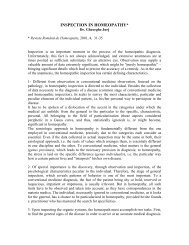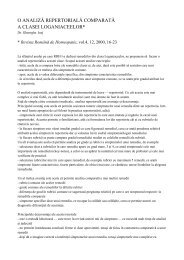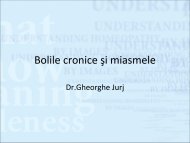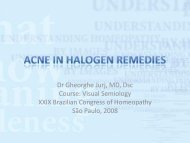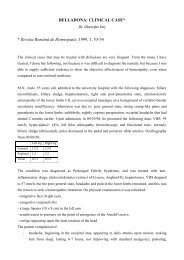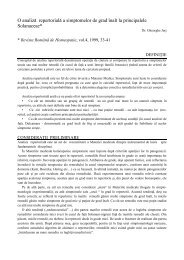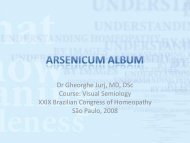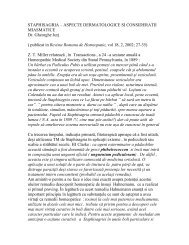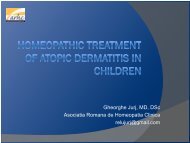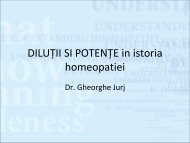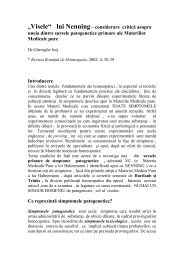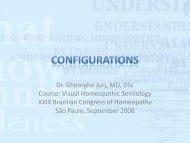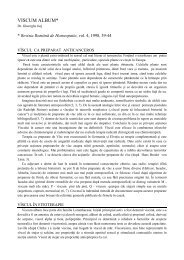BELLADONA* Dr. Gheorghe Jurj - Dr. Gheorghe Jurj - Homeopatie
BELLADONA* Dr. Gheorghe Jurj - Dr. Gheorghe Jurj - Homeopatie
BELLADONA* Dr. Gheorghe Jurj - Dr. Gheorghe Jurj - Homeopatie
Create successful ePaper yourself
Turn your PDF publications into a flip-book with our unique Google optimized e-Paper software.
<strong>BELLADONA*</strong><br />
<strong>Dr</strong>. <strong>Gheorghe</strong> <strong>Jurj</strong><br />
* Revista Română de <strong>Homeopatie</strong>, 1999,1,17-28<br />
Few among the homeopathic remedies have been so thoroughly studied concerning their effects as<br />
Belladona. Its first proving was performed by Hahnemann, who devoted to it 53 pages in the<br />
Materia Medica Pura. Allen quoted in his Encyclopedia (1880) almost 250 references.<br />
On the other hand, the pharmacological study of atropine – the main alkaloid in Belladona –<br />
became one of the keys to modern pharmacology; its action on the parasympathic system is a<br />
primary pharmacological model, learned in medical school together with the notions of vegetative<br />
nervous system and biochemical receptor.<br />
The botanical study of Belladona shows an extremely vigorous plant, which grows especially in<br />
calcareous soils, in the edges of forests or in valleys where shades temperate the light. It grows fast<br />
and vigorously, up to the height of a human being, with large leaves of up to 30 cm, dark-green;<br />
flowers are of violet, cianotic purple; the fruits have the shape of berries, a little smaller than wild<br />
cherries, black, of a sweetish taste, extremely poisonous for human beings and other mammals, but<br />
not to some species of birds.<br />
The plant grows so fast, that in one only season it reaches the height of a human being, with a<br />
strong stem and large leaves, which develop luxuriantly. Antroposophy authors suggest many<br />
speculations on the expansive, „inflammatory” character of its development, as well as its<br />
relationship to light and heat. To Anthroposophy, Belladona is the model of „inflammatory” plants,<br />
and in this sense, it is related to Apis – the model of animal inflammation.<br />
For didactic purposes, many of such speculations may held, and to know them may be helpful to<br />
realize the particularities of this powerful plant in its biological development, its toxicology, and,<br />
most especially, as a remedy. The speculative abuse by anthroposophists is a posteriori: after<br />
everybody knows how Belladona works, the connections between its characteristics as a remedy<br />
and as a plant may be easily posited, in order to supply a portrait of the plant, which may be useful<br />
as an aide-memoire.<br />
It is noteworthy that a plant with almost opposite traits, but a similar chemical composition,<br />
Mandragora, does not have accurate toxicological data. Proving data show that Belladona has<br />
many symptoms similar to another plant, Bryonia, although they do not share botanical similarities.<br />
It is hard to make predictions on the biological action of a plant exclusively from botanical data.<br />
Speculations come only after its biological activity was tested – toxicologically or homeopathically<br />
– in order to produce some milestones that help to understand it.<br />
The Latin name of the plant derives from the habit among Venetian women during the Renaissance,<br />
of dripping the juice from the fruit in the eyes to make them shinier, and thus, become more<br />
beautiful (bella-donna). The first part of the name, Atropa, comes from the third of the mythical<br />
Fates, Atropos, who would cut the fulfilled thread of life, together with Clotho and Lachesis. The<br />
toxic connotation of the plant may be also found in popular lore. In Greece it was called Manicon,<br />
from maniacum, madness; in Danish, Dwale, which means delirium; in English, Deadly<br />
Nightshade. In the Romanian popular culture it is known from long as a poisonous plant,<br />
Mătrăguna.
Toxicology and Pathogenesy<br />
From the multiple references made by Hahnemann, and later, all the homeopathic classic authors,<br />
the most certain data about Belladona are of toxicologic origin. The typical symptoms of the<br />
intoxication are the most significant and reliable. This is understandable, as its action is as toxic as<br />
complex.<br />
Basically, some modalities allow to systematically distinguish it from similar processes,<br />
aggravations and ameliorations that are much more recurrent than the physical symptoms, even in<br />
high dilutions.<br />
The issue of modalities is a serious problem. Most of the remedies have a biphasic action. The<br />
paradigmatic example is Opium: initially vivacious, full of ideas, restless, even violent, it later<br />
becomes atonic, suffering from a shortage of ideas and energy, parethic and abulic. Or Sulphur: fat,<br />
weak, too hot, too cold, craving for alcohol, rejecting alcohol (all 3rd degree symptoms in the<br />
repertory). Belladona, as the other Solanaceae, also presents many contradictory symptoms:<br />
- red face during fever / extreme paleness of the face<br />
- extreme excitability / extreme torpor<br />
- unquenchable thirst / thirstlessness<br />
- dryness of skin and mucosa / copious perspiration<br />
- extreme acuteness of the symptoms / chronic recurrence<br />
Such contradictory symptoms and modalities are explained, on the one hand, by the biphasic action<br />
of the remedy (first excitation and then inhibition of several functions), and on the other, by the fact<br />
that the provers are not completely neutral during a proving. They present their own reactional<br />
tendencies, dependent on their own constitution and typology, which make that systematically, the<br />
symptoms obtained in a proving represent the interface between the action of the tested remedy and<br />
the prover. Let us think of a proving of Belladona in a random sample of healthy individuals. A part<br />
of them would be sulphuric – hot, with a natural tendency to dramatic reactions -, another, silicic –<br />
cold, slower in reaction – or sycotic – with a natural humid tendency. It is only natural that these<br />
reactional types will exhibit different symptoms or different modalities. In toxicology, these<br />
reactional differences become blurred under the pharmacological action of the substance. This is the<br />
reason why the data of toxicology are extremely reliable, and constitute a large part of the base of<br />
the symptomatology of any remedy.<br />
Pharmacological action<br />
The chemical composition of Belladona is extremely complex; besides atropine it includes other<br />
alkaloids (hyosciamine, solanine, etc.) which make the pharmacological and homeopathic action of<br />
the full plant different from atropine’s.<br />
A review of the pharmacological actions with direct implications in homeopathic therapeutics must<br />
stress the following:<br />
1. Antiparasympathic action, through the interference of mediation at the level of the<br />
cholinergic synapses. The effects of this „atropinic” action are midriasis, dryness of mucous<br />
tissues and skin, peripheric paresia, etc. and an exacerbation of the influence of the<br />
sympathic component of the vegetative nervous system.<br />
2. Direct action on the brain cortex, with the appearance of hallucinations, delirium or torpor.<br />
3. Direct action on the centers of termorregulation, with a tendence to provoke hyperthermia.<br />
4. Strong action on the vascular system, probably through vegetative mechanisms, with a<br />
tendency to congestion, hyperemia, increase of the arterial pressure and the pulse, peripheral<br />
vasodilatation, etc.
5. Irritation of the medulla and brain stem, with the appearance of muscular contractions,<br />
spasms, fasciculations, seizures.<br />
6. Depression of the respiration center, after a phase of excitation.<br />
7. Locally, appearance of inflammatory phenomena, with a tendency to evolve fast.<br />
To keep in mind these actions may help to understand the rich homeopathic symptomatology of the<br />
remedy, especially its model of reaction in the many affections where it is indicated.<br />
Typology<br />
In principle, Belladona maybe prescribed in any constitution and diathesis when the symptoms<br />
indicate it. It is a primary a remedy for acute conditions. However, clinical practice shows a higher<br />
incidence of the remedy in a certain typology, albeit less definite than in other remedies.<br />
Belladona is a major acute remedy in children of carbonic constitution who manifest reactional<br />
psoric tendencies. Although the famous saying, „Belladona is the acute of Calcarea carbonica” is<br />
regularly verified in practice, the remedy is more helpful in children with a healthy immune system.<br />
Children who present diseases in acute crisis, where Belladona is extremely useful, are in general,<br />
in equilibrium, and the diseases begin suddenly, evolve fast and dramatically, with high fevers and<br />
violent inflammatory symptoms, to disappear without leaving traces, after massive perspiration.<br />
The danger in these children is the appearance of febrile seizures, due to the violence of the fever.<br />
The reactional mode of the Belladona type is the reactional mode of the sthenic child, the healthy<br />
child, who fights external aggressions by employing the most common of modalities: fever. At<br />
times, after a period of homeopathic treatment, children who present asthma attacks or are<br />
permanently subjected to torpid, endless catarrhs present a violent febrile reaction which requires<br />
Belladona. This is a safe sign of the restauration of the immune equilibrium, and the use of<br />
antibiotics may interfere in this effort of immune reconstruction.<br />
Among the adults, the individuals whose diseases require Belladona are usually normosthenic, with<br />
a natural tendency to sympathicotony. There are some traits that indicate the possibility of this<br />
remedy as typologic:<br />
- A physical inclination to plethora. Usually, they are carbonic: hot, dynamic, with congestive<br />
vascular reactions (Calcarea, Sulphur, Aurum) to physical or psychological stress. The skin<br />
is rather fatty and thick; antecedent of furuncles.<br />
- Generally equilibrated people, sthenic, with an appetite for life and work, but who present a<br />
striking irritabilty, which makes them violent and dramatic. A male equivalent might be Nux<br />
vomica or Sulphur (with which it has acute-chronic relations). A female equivalent might be<br />
Chamomilla (which at times is a differential diagnosis), more spastic and vehement, but less<br />
congestive.<br />
- Upon contradiction, injustice, frustration, tiredness (Staphisagria) or physical indisposition<br />
(menstruation) it may present full rage, with verbal or physical violence, on the edge of<br />
delirium. In pleasant conditions, they are kind people, full of good will, ready to help<br />
everybody around. Anger leaves no traces if it is expressed. During the rage attacks, the face<br />
is congestive, hot and radiant, the pulse is accelerate and the blood pressure is high. The<br />
clinical picture of Belladona rage might be devastating both to people around and the patient<br />
him/herself, to the limit of apoplexy. It is associated to congestion of the head, pulsations<br />
are felt in the head, the carothyd pulse becomes visible and is acutely felt, forcing to free the<br />
neck from constricting clothes (as Lachesis, but without the feeling of general constriction,<br />
BUFERILE, acute lack of air), the eyes become glassy and look “wild” (3 rd degree in the<br />
repertory). Stramonium is less congestive, with striking self- and heteroagression, violent,<br />
but “cold”.<br />
- High sensitiveness to rage, especially if repressed (which is difficult). After repressed anger,<br />
an unbearable migraine might follow, with photophobia, intolerance to the presence of
others and a need of absolute silence.<br />
- Although sthenic, it presents an extreme sensitiveness – related to the sympathic tonus.<br />
Sensitiveness to noise may be extreme, the least sound may turn him/her nervous and<br />
violent.<br />
- It is very sensitive to anything that affects the head. <strong>Dr</strong>afts of hair, haircuts (migraine after<br />
haircut is a keynote), washing the hair, cold in the head or exposition to the sun (it is very<br />
sensitive to the sun, and its heat may trigger or aggravate all the symptoms), heat and strong<br />
lights (many cases of ophtalmia by snow require Belladona) may aggravate.<br />
- Generally healthy, it presents violent forms of acute diseases, with high fever which<br />
improves by perspiration, but without thirst. During disease, it is irritable, prefers to be<br />
silence, cannot bear to be cared for and becomes quarrelsome when disturbed.<br />
- It relishes food, meat, but it is uncommonly sensitive to alcohol (as Hyosciamus and<br />
Stramonium), which may make it quarrelsome, developping true delirium upon frustration<br />
(Stramonium) or jealousy (Hyosciamus), extremely violent, with the same congestion and<br />
wild stare.<br />
Reactional model<br />
Indifferent to the localization of pathology or the clinical syndrome, Belladona manifests a true<br />
reactional model hard to mistake for another remedy. Frequently, it is this reactional model, rather<br />
than isolated symptoms or clinical indications, which leads to the identification of the remedy. It is<br />
hard to say whether this reactional model is the „genius” of the remedy, but is certain that if the<br />
practitioneer succeeds in identifying it may use it as the grounds of its choice, when neither a<br />
repertory analysis nor the „totality of symptoms” would justify its prescription.<br />
Belladona is a remedy almost unmistakable in its reactional model. The diagnosis of Belladona is,<br />
as many of its symptoms, one that unfolds in acute conditions. Thus, its identification depends on<br />
some safe signals which ought to be accurately identified.<br />
- The first sign is the same that gave the plant its name: a particular shine in the eyes, harder to<br />
describe than to recognize. Whoever saw it once will recognize it forever. It is described as a „fixed,<br />
wild brightness”. In clinical practice, it is less frequent to identify the „wild” qualification as such<br />
(especially in children). On the contrary, the „brightness” of the eyes, caused in part by the<br />
congestion of the conjunctive and lids, in part by a fixedness caused by midriasis and some degree<br />
of pupil INABTABILITATE, is the rule. If this stare appears in a patient, Belladona is to be<br />
thought of. Differential diagnosis includes Stramonium, which may present a really wild stare, and<br />
which also manifests violence against the people around; especially in children, the stare of<br />
Stramonium is unmistakable: frowning, hard; violent behavior may be elicited by the most trivial<br />
causes, as e.g. the intention of the doctor to perform a physical exam. Belladona allows the doctor<br />
to perform an exam, Stramonium more hardly, and eventually reacts very violently against his/her<br />
mother. Another particular stare that must be distinguished is Lachesis, equally congestive, but<br />
mobile (Lachesis violent rage is at times associated to jealousy, which may appear in children<br />
regarding a sibling or one of the parents. The latter, in my opinion, is a keynote of Lachesis.<br />
Lachesis are children that do not bear to look at tender scenes, not even his/her parents touching). A<br />
further remedy that presents midriasis and bright stare is Atropinum suphuricum, but its symptoms<br />
are not violent and usually, neurological.<br />
The stare of Belladona may appear in the course of an acute inflammation or congestive syndrome<br />
(fever, migraine, pains), but it may be an index for a more thorough investigation in recurrent or<br />
chronic ailments (epilepsy, uterine bleeding, paralysis).<br />
- In the reactional model of Belladona we will always find the brutal suddenness of the appearance<br />
of the symptoms, either in acute or recurrent affections. The beginning of the Belladona syndrome<br />
is dramatic: fever increases from one moment to the other upon a state of good health, seizures<br />
appear suddenly, after the least excitation, pain comes abruptly, preceded by nothing. In the
epertory we find it in „sudden” in the 3 rd degree. Symptoms appear suddenly, are manifested<br />
suddenly and end equally suddenly. Between episodes, the individual is healthy, perhaps a little<br />
sensitive to the influence of external factors, which in a homeopathic framework belongs to the<br />
category of causality. During the acute attacks (be migraine, fever, pains, seizures) Belladona does<br />
not bear the least sensorial excitation, and wants to be “left in peace”.<br />
Causality (triggers)<br />
- Psychological: overwhelming fright, or which the individual interprets as „overwhelming”,<br />
notwithstanding they actually being mild sensorial impressions or phenomena of the<br />
imagination, such as visions of ghosts, etc. <strong>Dr</strong>eams may also be dramatic: dangerous<br />
situations (fire, persecution, wild animals). Very frequently, symptoms appear after rage<br />
(expressed or repressed), the least conflict in the workplace or with the family, a minor<br />
misunderstanding may trigger the appearance of symptoms.<br />
Cannot bear anyone around, even if solicituous and discrete. In acute affections, does not<br />
like to be cared for, hates efforts made for him/her (be an unrequested cup of tea, or a<br />
remedy he/she does not think is needed. Belladona does not reject remedies because he/she<br />
fears to be poisoned, as Hyosciamus, but because he/she wants to be left in peace and is sure<br />
that will heal by his/her own powers). Aversion to conversation.<br />
- Physical: the exposition to minor factors may trigger the appearance of major symptoms.<br />
There is a special tropism for the HEAD.<br />
Cold: Belladona presents acute inflammatory syndromes after the exposition to cold<br />
(contrary to Silicea and Pulsatilla; the same as Nux vomica). Symptoms extend downwards,<br />
while the feeling of heat upwards. Cannot bear cold at all, especially in the head.<br />
Sensitiveness to cold and drafts of cold air put it among those who always close the<br />
windows (as Nux vomica and Rhus – tox; inverse to Lachesis and Pulsatilla, which desire<br />
fresh air). From here, the tendency to cover him/herself, although excessive warmth is<br />
equally aggravating.<br />
Heat: Cannot stand excessive heat nor large variations of temperature. Cannot bear to be in<br />
a heated room (Pulsatilla), but more especially the exposure to the sun (beach), which<br />
aggravates all the symptoms.<br />
Sun: exposure to sun or the heat of the sun elicits clear aggravation (the same as Glonoinum,<br />
Amyl nitrosum, Lachesis, Sanguinaria). Probably, it is one of the major remedies.<br />
Wind: especially strong winds; especially under conditions that increase sensitiveness<br />
(perspiration, wet hair) (Same as Aconitum, Hepar sulphur, Nux vomica).<br />
Bathing: after bathing, especially if the head remains wet (Dulcamara, Aconitum,<br />
Antimonium crudum).<br />
In my practice, I treated a 17 year old girl, who had facial paresia after washing the hair and going out with the<br />
hair still wet. It was spectacularly cured with Belladona.<br />
Hair: particularly sensitiveness of the hair (haircut, combing).<br />
Alcohol: after drinking alcohol may appear a state of maniac rage in an individual usually<br />
quiet, or symptoms of major intoxication, with vertigo, confusion, CLASTIC tendencies.<br />
Noise: Cannot bear noise, which irritates or aggravates.
Motion: Cannot bear motion, neither vertical (rising or sitting; airplanes; elevator) nor<br />
horizontal (dizziness when moving the head on the pillow). In migraine, even the motion of<br />
the eyeballs aggravates (same as Bryonia, which is not congestive but pale, and with<br />
remarkable digestive symptoms). In symptoms which generally aggravate by motion,<br />
Bryonia is the first differential diagnosis, and it can be very difficult to establish. A keynote<br />
is that in Bryonia the face is usually pale, even when presenting signs of local inflammation,<br />
while the face of Belladona is almost always congestive.<br />
Light: Cannot bear light, neither natural (sun; extreme sensitiveness to sunlight, perhaps the<br />
most sensitive of them all) nor artificial. Even reflected light (water surface, mirror) may<br />
trigger headache or vertigo. Photophobia is one of the most reliable symptoms of the<br />
remedy; it may be aversion to excessive light stimuli (camera –flash, strong lights in a<br />
room) or even a general aversion to light (and buries the head in the pillow, as in migraine<br />
and fever).<br />
Aspect of the patient<br />
At times, the aspect of the patient is decisive in the choice of the remedy. In Belladona, the head is<br />
fully congestive, the ears are red, the carotid pulse is visible. At times diffuse red spots appear on<br />
the face, throat and chest, which alternate in a mapped way with areas of discoloration. Other times,<br />
all the face is red, or on the contrary, pale. Indifferent of the aspect, the head irradiates heat. This<br />
can be perceived from a distance, and it appears even in the absence of fever. In general, the body is<br />
hot, irradiates heat, but the extremities are cold, especially the leds, that can be icy cold. The<br />
impression to the observer is that the heat concentrates on the head. But after the full picture is<br />
unfolded the heat reaches also the extremities, and this is often a sign of cure or to move to another<br />
remedy.<br />
There are two kinds of behavior in the patient:<br />
- Calm aspect: The patient is torporous due to the disease, refuses to move, to talk, buries the<br />
head in the pillow to avoid any sensorial excitation. Is indifferent, apathic, at times, even<br />
sad. Mental confusion is typical, and it can be observed on the patient’s face. Difficulty to<br />
answer to questions, mistakes people around him/her or the place where he/she is, does not<br />
know what is the matter with him/her (which exasperates the people around). At times,<br />
aspect of a calm delirium. It is the model in fever (especially in children) and migraine.<br />
- Agitated aspect: The patient speaks continually, gesticulates, the face reflects agitation or<br />
fright; sits for a few seconds, then rises up, goes restlessly from place to place, twists<br />
him/herself to alleviate the pain, calls for the people around but then abuses them. At times<br />
agitation may be so intense that wants to escape from the house or the hospital, even<br />
jumping through the window. This is the maniac aspect that appears in delirium, spasm or<br />
intense pain, especially in adults. Provings describe the acute phase of mania, with terrible<br />
hallucinations (sees ghosts, dogs, giants, etc.) which lead to an expression of fright on the<br />
face, extreme agitation and increase of strength („three persons were needed to hold him”).<br />
CLINICAL SYNDROMES<br />
The symptoms that characteriz Belladona as a remedy are countless, thus a list from head to toes, as<br />
the presented in the materia medica would be useless in practice. Belladona, as most of the<br />
homeopathic remedies, has an extraordinary ability to keep its reactional model, causality and<br />
specific modalities in any pathology, indifferent to any localization and diagnosis. As Vithoulhas<br />
remarked, the field covered by Belladona is immense, it may be useful almost anywhere, even in<br />
situations not described in the materia medica, whenever its reactional model is taken into account.
Thus, it seems more useful to try to establish the association of symptoms that configurate true<br />
clinical syndromes of Belladona, in order to increase the probability of a more accurate prescription<br />
of the remedy.<br />
In the context of the syndromes of a remedy, there is a remarked constancy of the general symptoms<br />
which express the reactional model that has been discussed, but at the same time there is also a<br />
variability of the individual symptoms, that allows to judge more accurately and supply an image of<br />
the remedy. The acquaintance with the homeopathic syndromes allows for an approximation to a<br />
rational clinical practice, in continuity with the conventional approach to diagnosis. That which the<br />
prominent conventional clinicians had defined as „clinical forms” are often superb descriptions in<br />
which we may recognize true homeopathic clinical syndromes. Thus, their neglection by so-called<br />
modern medicine is a loss for medicine as a whole and for each and every patient.<br />
Exactness and flexibility are the two pillar of homeopathic practice, in diagnosis (which requires the<br />
same accuracy as in conventional medicine, but in the specificity of the individual patient), and<br />
more especially in therapeutics (where, besides the exact remedies, small coadjuvant remedies may<br />
be prescribed, thus, it is necessary to define whether the occasion is fitting or not for a definite<br />
action or, on the contrary, if it is necessary to merely assist the organism to overcome a<br />
physiological impasse).<br />
The materia medica of Belladona shows that it is a major remedy for acute states. The chronic<br />
conditions in which it may be useful are less known and require special attention.<br />
ACUTE CLINICAL SYNDROMES<br />
All the acute syndromes in which Belladona is useful have a sudden character in their appearance<br />
and manifestations. The identification to inflammation is one of the most frequent descriptions of<br />
the remedy, and in most of the Belladona syndromes we find the characteristic signs of<br />
inflammation:<br />
- HEAT: it is one of the hottest remedies in the materia medica (although not the hottest).<br />
Indifferent from the pathology, we will find intense heat in the symptoms. It may be general<br />
(fever) or partial (in the affected areas) heat or „psychological heat” (delirium). On the other<br />
hand, individuals showing the chronic typology of Belladona are frequently solicitous,<br />
warm people, that jump to help those around them. One of the reliable physical signs of<br />
Belladona is radiant heat, that may be perceived by applying the hand at some distance from<br />
the forehead (general) or the affected area.<br />
- REDNESS: there is always something red, inflammated in Belladona. It might be fiery red<br />
as in scarlet fever or erisipela, a diffuse reddish rash, congestion of the pharynx, etc.<br />
- PAIN: the congestive pains are acute, and have the particular characteristic of being<br />
pulsating, as if the affected area was feeling the arterial pulse. The typical congestion of<br />
Belladona is active, arterial, and pain is aggravated by all factors increasing local irrigation.<br />
- SWELLING: may be local, inflammatory, but may reach the meninges and provoke general<br />
symptoms. In local pathology we find swelling of the conjunctiva, tympanic membrane,<br />
pancreas, etc.<br />
According to our experience, the acute pathology of Belladona may be sorted in five major acute<br />
syndromes:<br />
1. Febrile syndrome
2. Inflammation syndrome<br />
3. Algic and spasmodic syndrome<br />
4. Maniac syndrome<br />
5. Paretic/paralytic acute syndrome<br />
1. FEBRILE SYNDROME<br />
A primary and the most frequent clinical indication of the remedy, where it is effective, especially<br />
when the image of the fever overlaps its reactional model. In carbonic children it is the most<br />
frequent remedy for fever, and the parents may employ it until the visit to the doctor. The sooner it<br />
is used, the faster its effect. Moreover, in these children Belladona has a prophylactic effect on<br />
febrile seizures, to which they tend. Fever usually begins on a fully healthy individual, preceded by<br />
chills.<br />
Chills are associated to fever in the general conditions of aggravation of the remedy: upon<br />
undressing or uncovering parts; after sensorial excitations (light, noise); after eating; after washing<br />
the hair. Chills may also appear isolatedly after exposure to sun or when the body is wet.<br />
Aggravates by hot drinks. During the chills, the face is congestive, but it may become pale upon<br />
lying down. Chills usually appear before the fever, but may also appear after perspiration. They<br />
may be associated to stupor, loss of conscience or delirium.<br />
Fever does not have a precise time to appear, but it more frequent in the evening, appearing<br />
suddenly and violently in the night, when it may or not be followed by perspiration. This sudden<br />
appearance is not necessarily accompanied by chills, and the first sign may be a state of torpor<br />
together with the beginning of the sensation of radiant heat, heat in head and cold extremities. The<br />
skin may be pink-reddish, as in scarlet fever. The stare is bright, the eyes are congested and with<br />
midriasis, the patient rejects light, and is also sensitive to noise.<br />
During fever, the blood vessels are dilatated, and the patient may complain of an unbearable<br />
headache. Cannot stand to be covered. High, dry heat, which may alternate with chills. At times, the<br />
patient may be very thirsty, as the mucosa are always dry, but it is not unfrequent that he/she<br />
refuses liquids. Lemonade and warms drinks ameliorate, while too cold or too hot drinks may<br />
trigger chills or delirium (as it may appear after the least sensorial excitation). In our experience of<br />
hundreds of febrile diseases treated with Belladona, there was one only case, a 10 year old girl, with<br />
extreme agitation and violent delirium from the beginning.<br />
Easy perspiration closely follows the fever and decreases it. At times, before prescribing Belladona<br />
it may be useful to prescribe a few doses of Aconitum, which favors perspiration. Perspiration may<br />
appear paradoxically in uncovered parts, and the general state may also improve by uncovering for<br />
short periods of time. At times, perspiration extends upwards. An odor as burnt has been described,<br />
as of smoke, of perspiration (which we have not verified until now).<br />
The febrile syndrome may appear before menstruation (and the premenstrual syndrome of<br />
Belladona is one of the most febrile and hot), after fright, rage or other emotions, during seizures.<br />
The most typical febrile syndromes, which look like the description of Belladona in the provings,<br />
are the chidhood infectious diseases (rubella, but especially scarlet fever, held by many as the<br />
„model” of Belladona disease), but it may be associated to all local inflammations.<br />
2. INFLAMMATION SYNDROME<br />
The inflammatory diseases trustfully treated with Belladona are the ones that present the most
typical symptoms of inflammation. Against Kent’s saying, that homeopathy seeks for the „strange,<br />
particular, unusual”, Belladona is a good example of a remedy in which the general is at the same<br />
time typical, and significantly typical and maybe the ground for a prescription.<br />
Inflammations presenting signs of Belladona may appear in any localization: NET, skin, eyes,<br />
internal organs, urogenital system.<br />
NET affections. Ailments are dramatic. The physical exam shows acute inflammation, although<br />
rarely suppurative, everything unfolds as if an acute suppuration was in the way, which may appear<br />
indeed later or not appear at all. The high fever and the intense symptoms lead to the regular<br />
prescription of antibiotics, although frequently they are only viral affections to which the organism<br />
reacts intensely. An early prescription of Belladona makes useless the intervention of antibiotics in<br />
most of cases. On the other hand, the apparition of suppuration is one of the safest signs that<br />
indicate the need to move to another remedy (especially from the Mercurius group).<br />
Acute sore-throat. The mouth is dry, extreme dryness of the pharyngeal mucosa, without thirst or if<br />
thirsty, cannot drink liquids. The pillars, tonsils and all the pharyngeal mucosa are inflammed, the<br />
color is fiery red (as in Phytolacca, but not as cianotic as Lachesis), with moderate swelling (less<br />
intense as Apis). The aspect is shiny. Cannot swallow, especially liquids. High fever associated to<br />
other signs of the remedy. The throat is painful as a whole, feels increased in volume, which at<br />
times is objectivized through acute adenitis. Cannot bear anything tight on the throat. It is the main<br />
remedy in the congestive stage of tonsillar abscess, to be prescribed as a rule, while observing<br />
attentively the patient to move to Mercurius.<br />
The first tonsillar abscess I treated exclusively with homeopathy was in a 7 year old child, of evident carbonic<br />
constitution. After an antibiotic treatment, first with eritromycin and then with a cephalosporin, initially p.o. and later<br />
parenteral, the high fever continued, alternating with afebrile intervals. Locally, the signs of tonsillar abscess were<br />
evident, but without suppurative amygdalitis. The right tonsil was very congestive, the pharynx was intensely<br />
inflammated, a swelling was tangible at the base of the throat, it was hot; the child could not bear the least touch on the<br />
throat, even to open the mouth during the physical exam was agony: the change in the position of the jaw-bone<br />
provoked tears of pain. The alternatives were to continue with antibiotics or Belladona. I chose the latter, in a low<br />
dilution, 6D, following the patient every 4 hours. In the night, intense perspiration appeared, requiring many changes of<br />
the clothes; then the throat was invaded by pus, which was manifested as vomiting. After this, the body temperature<br />
stopped raising, and the prescription of Cinnabaris, followed by Mercurius vivus in low dilutions solved the case.<br />
Without surgery, which seemed necessary at the beginning. After this episode, I prescribed Calcarea carbonica and<br />
Sulphur once in a while, and the patient never presented again a critic condition as this one. However, I do not<br />
recommend to choose homeopathy in this kind of cases, unless the doctor feels safe enough to prescribe and may<br />
closely follow the patient in order to decipher the signs of the evolution. This case taught me that even the most<br />
dramatic pathological situations may be solved with homeopathy, provided the doctor devotes all his/her effort to<br />
decipher the symptoms and may fully appreciate the consequences of the therapeutic action.<br />
Otitis. Otites in Belladona are generally congestive, with severe pain, pulsating, which extends<br />
everywhere: to the face, forehead or the occipital area, at times below the throat. Sudden<br />
appearance, high fever, hides the head in the pillow to cover the affected pain. Aggravates by any<br />
motion of the head, noise (presentes tinnitus, hyperaudition), cannot bear the least draft of air.<br />
Attention to the otites of swimmers!<br />
Sinusitis. Sudden beginning, with high fever and unbearable pain, more in the frontal than the<br />
maxilar sinus. At times epistaxis appears of red blood. Secretions are not copius, pain (pulsating, as<br />
if the heart is beating in the affected area) predominates, aggravates bending forwards or by motion.<br />
Eyes. The eyes are the target-organs of Belladona, and must always be taken into account. Acute<br />
conjunctivitis which appears after sensorial excitation, with acute congestion, redness; eyes look<br />
teary, bright (clinically inconfundible), cannot stand the least light. Pain may be intense, burning, as<br />
if sand in the eye, easy swelling of the lids. The conjunctivis represent an algorythm verifiable in all<br />
the syndromes of Belladona: brightness – congestion – midriasis – photophobia – lacrimation.
However, the opposite symptoms may appear: miosis, dryness. Blurred vision, as if through a mist,<br />
ambliopia, diplopia, weakness on the vision of light.<br />
Internal organs. The most common inflammations that require Belladona are acute cholecystitis,<br />
pancreatitis and pyelonephritis. In acute cholecystitis, the pain is severe, with all the modalities of<br />
aggravation of the remedy (motion, touch). The patient lies on the affected pain to protect it from<br />
motion. High fever, preceded by chills that disappear suddenly and reappear. Belladona must be<br />
always associated to biliary drainage. Acute pancreatitis, especially in men after excessive BAHICE<br />
is another major indication of Belladona. At times the pain is so intense that does not improve with<br />
conventional antispasmodics nor their equivalent remedies (Colocynthis, Magnesia phosphorica,<br />
Cuprum), but ameliorate with Belladona. In practice, I have seem that, as a rule, these patients are<br />
extremely agitated and irritable, the intervals in which they are „în cocoş de puşcă“ are short, they<br />
become suddenly agitated, rise from bed and react agressively when solicited.<br />
A patient that later responded wonderfully to the remedy, stayed 2 days at a hospital before intempestively leaving it,<br />
indignant because it had not received „a shot to make pain stop” (WANTS TO ESCAPE is a rubric of high degree in the<br />
repertory). At the first consultation, he was in a state of extreme excitation, borderline with delirium. He entered in my<br />
office without taking notice of other patients in the waiting room, interrupted a consultation in process. A particular<br />
stare, shiny, evenWILD LOOK) was evident, and the feeling of heat emanated from the head was very intense, although<br />
the general temperature of the body was not febrile. I gave Belladona 10D with an antispasmodic homeopathic formula<br />
A WHAT??? every hour. On the second day the pain ceased, and the aspect of the patient was calmer, becoming<br />
cooperative and patiently waiting for the moment of his consultation. It was remarkable the change in his stare: not only<br />
calmer, but also softer, the impression of „madness” had disappeared.<br />
Belladona ought to be included in the ER and ICU as one of the main remedies. Even if its use<br />
would be ineffective in the cases that do not require it, the immense good it brings in the suitable<br />
cases cannot be substituted by any other remedy.<br />
In acute pyelonephritis, Belladona may be one of the main remedies, although the disease will<br />
usually also need antibiotics or remedies with renal tropism. If the general state of the modalities<br />
require it, it must be used in association (with antispasmodics and antithermics) or not. As single<br />
remedy it appears, usually, in the first stages of acute pyelonephritis, i.e. the congestive phase, with<br />
high fever, colics and chills; later, remedies with renal tropism are indicated (Sarsaparilla,<br />
Equisetum, Benzoic acidum, Pareira, etc.) In the acute inflammatory phase of the disease, the<br />
patient must always be observed. If there signs of Belladona, nothing else would be able to<br />
ameliorate the patient so much and so fast.<br />
In urogenital inflammations (cystitis, urethritis, prostatitis) the key symptoms are local throbbing<br />
and heat. Belladona always irradiates heat, and the most significant sensation is local throbbing, at<br />
times unbearable, associated to lancinant pains, most usually associated to a feeling as arterial<br />
beatings in the affected parts. In Belladona, almost always there will be a sensation as if „the heart<br />
is beating in the affected part”. There is high sensitiveness to touch, pain appears and disappears<br />
suddenly, with agitation.<br />
In the inflammations of the genital organs, Belladona is useful in patients with right side<br />
dominance, with severe pain, pulsating, and fever. Fever may rise spectacularly, even in anexitis,<br />
which acquires the dramatic aspect of pyosalpingitis. The feeling of pelvic congestion is intense,<br />
with feeling of bearing-down of the uterus. The sensitiveness to touch is extreme (as in<br />
Chamomilla, but here it is more spasmodic and less febrile). There is non menstrual bleeding, blood<br />
feels hot, is dark red or may have clots.<br />
Menstruation may come early, usually with a congestive premenstrual syndrome. As in all<br />
congestive remedies, menstruation amelioratesw the other symptoms and the general state. At<br />
times, there is amenorrhea after a rage, sensorial excitation, cold or exposition to sun, which is<br />
associated, almost as a rule, with acute hypertension and migraine. In our experience, women<br />
requiring Belladona are very sensitive to oral contraceptives. In treatments of hormonal
suppression, the symptoms are aggravated.<br />
Skin. The skin pathology of Belladona is very rich. The skin is very sensitive: to cold, touch, sun.<br />
After such kind of expositions, the skin becomes rough and red, as in scarlet fever. In important<br />
cutaneous inflammations, erisipela (the first remedy to consider), abscesses, furuncles Belladona is<br />
useful until suppuration begins. The general symptoms are noteworthy, with high fever, and other<br />
characteristics of the remedy. At times, small indurations may appear below the skin, as tubercles or<br />
eczematides. After other remedies had failed, it may be useful in acne, especially in the sulphuric<br />
type, where acne is predominantly inflammatory, elements covering a large surface (as if small<br />
furuncles), with pain before collecting, especially in the head (in these cases, Belladona 30C or<br />
200C is more useful than lower dilutions).<br />
3. ALGIC SYNDROME<br />
It appears, usually, in an inflammatory context, but may also be spasmodic. Its characteristics are:<br />
- sudden onset, high intensity, equally sudden disappearance.<br />
- more frequently, pulsating; also bulging and drawing.<br />
- irradiating to the neighboring areas.<br />
- triggered and/or aggravated by motion, noises, light, etc.<br />
In spasmodic syndromes, abdominal colics appear, at times very intense, biliary and kidney colics.<br />
A special indication is the onset of acute pancreatitis, where it may be spectacular. Dilutions to be<br />
used are usually low (6-10D, 5-7C) in frequent repetitions.<br />
The same indication of low dilutions is convenient is bronchial spasm. In this case, Belladona has a<br />
striking particularity: febrile cases, while usually, asthma attacks have low or no fever.<br />
Sciatica is usually on the right side, extends speedly and constantly to the ankles, feeling of drawing<br />
and throbbing, pain is severe, as if the full nerve was inflammated. It appears after cold baths or<br />
after the body was heated and exposed to the wind, ameliorates in perfect rest, but it aggravates by<br />
motion in bed or turning from one side to the other.<br />
Other neuralgic pains have the same characteristics.<br />
4. MANIAC SYNDROME<br />
May appear:<br />
- in a febrile context<br />
- in the maniac phase of the bipolar disturb<br />
- in delirium tremens<br />
- in the pre-apoplectic phase of a stroke<br />
It presents a typical violent aspect, with many hallucinations, bright, wild stare, and characteristic<br />
congestion of the head. It is one of the most violent remedies in the materia medica, and all three<br />
poisonous Solanaceae are considered important homeopathic remedies in the maniacal syndrome.<br />
During a maniac attack, behaviour is strikingly violent: trend to strike, to bite (things or people<br />
around), to jump from bed with a desire to escape, to bark, gnashes the teeth, tears his/her clothes.<br />
Very loquacious, speaks nonsense, laughs without cause, gesticulates, extravagant gestures. The<br />
hallucinations may influence the behavior: sees terrifying, hideous faces, ghosts, black dogs,<br />
wolves, insects or fires. Fears what he/she sees, and wants to flee from these hallucinated images,<br />
and does not recognize his/her parents or the people around.
5. PARETIC AND PARALYTIC SYNDROMES<br />
Belladona is an important remedy in the acute stage of hypertensive strokes. The face is congestive,<br />
hot, red, carotids pulsate, anxiety and fixed stare. In conditions that precede a stroke or at its onset,<br />
Belladona is to be prescribed precociously, in high dilutions frequently repeated (30C every 15, 30,<br />
45 minutes), even if associated to diuretics.<br />
Other circumstance where Belladona is useful is facial paresia by cold.




